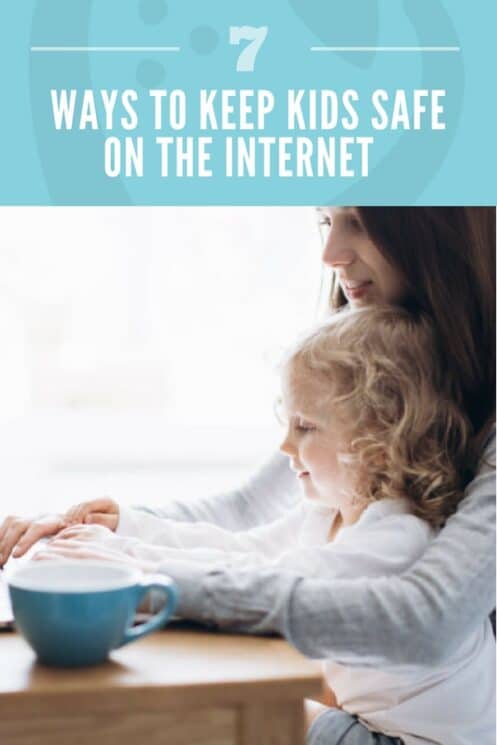7 Ways to Keep Kids Safe on the Internet
The internet is magnificent at providing information to us in seconds. Without leaving home, we can research practically anything, read the news, get the weather forecast, play games, watch movies, communicate with the world, and more. But it can also open your family to potential trouble unless you have safeguards in place and remain vigilante in monitoring internet activity. We have 7 tips to share with you to keep your kids safe on the internet. Of course, you will approach internet safety differently for different aged children, so use the following at the appropriate ages/stages for your child.

7 Ways to Keep Your Kids Safe on the Internet
Set up parental controls
How do you do this? Here are some options:
- Router. Configure parental controls on your router which will allow you to have internet filtering on all of the devices in your network. For routers with built in parental controls, use the router’s manual to guide you in setting it up. If your router doesn’t have parental controls, you can use OpenDNS with your existing router for filtering Internet content.
- Internet Service Provider (ISP). Your ISP may offer parental controls. Ask your ISP for information or search for ISP parental control in your search engine to find out what is available.
- Your device’s operating system. Your device’s operating system likely has built-in parental controls. Using the most up-to-date version of the operating system would allow you to maximize the benefits of the parental controls offered.
- Web browser. You can set up parental controls through your web browsers. Many web browsers offer settings and add-ons to make the internet more age appropriate. For information about parental controls available through browsers, click here.
- Kids browsers. There are browsers specifically designed for younger children that may be too limiting for older kids. Some kid browsers can be found here.
- Software controls. Parental control programs exist that let you limit screen time, block websites, and monitor your child’s internet activity on your own computer. The Best Parental Control Software of 2017 lists several options that are available.
- Mobile devices. Mobile devices may come with parental controls that you can set up or you can download apps to allow you to set up parental controls. A few options can be found here.
Keep all electronic devices, computers, phones, and more in the common areas of the home and monitor what your children are doing.
Don’t forget about devices issued by school and gaming systems. These devices can open your child to more than you’d like.
Set up limits/expectations.
There are various ways to set limits. Here are a few:
- Have an internet/electronic device contract with your child. In the contract, explain that you are allowing your child to use the internet with the expectation that he/she follow your rules and that you will be able to monitor internet activity at any time. Setting this up from the beginning establishes your family’s rules for internet use, which is helpful in guiding your child’s behavior. Examples of some internet usage contracts can be found here.
- Have approved sites that your child may visit, and if he wants to go to another page, he must get permission first.
- Have a shut down time. We have a time restriction set up through our router so that the internet isn’t available on our kids devices from 8 pm through 8 am. Another idea is that phones and other devices get charged in the parent’s bedroom for the night to keep your child from being tempted to check emails, texts, Facebook, and more.
- Do not open anything that you are not familiar with. Whether it’s a document, a photo, an email from an account you don’t recognize, et cetera, teach your children not to open it if you aren’t familiar with it or expecting someone to send it to you.
- Since the start of using the internet, I asked my children to immediately come to an adult if they experience, see or hear anything that doesn’t seem right to them. Also, if anyone tries to contact them, they are to let an adult know immediately.
Time for a phone?
If you allow your child to have a phone, what will he/she have access to? It’s up to you to set up limits or else the phone can turn into unlimited access to the full internet. Think about what your child needs when giving a phone. We gave our twelve year old a phone when she started traveling with other families to some soccer games. It is capable of making and receiving calls and texts. Those features are all she needs right now.
Keep private information private
First, you’ll need to teach your child what is private, such as names, addresses, your school name, your neighborhood name, photos, telephone numbers and other identifying information. Then teach your child not to share information about themselves without your permission. Passwords are also private and should not be shared with friends. Remind your child to sign off when finished on a site that requires a password so that no one can come along and use your child’s account.
Be vigilant
Many of us have slipped up. Learn from it and move one. I allowed my daughter to listen to Kids Bop on her device while cleaning her room. She then asked if she could listen to Let It Go on YouTube. I said yes. Then she joyfully came to get me so that I could listen to the funniest Frozen song. When she started it, at first it was crude, then there was a curse word. How was it possible for her to get to this? It’s possible because on the right hand side of YouTube, there are suggestions for what to listen to next. This Frozen parody, complete with an animated video, was waiting there, looking innocent.
Also, determined children can get around some of the parental controls that you may set up, so monitoring and being vigilant at overseeing your child’s internet activity is always important.
Be aware of cyber bullying
Cyber bullying can occur through many ways, such as through text messages, blogs, websites, and more. Stomp Out Bullying has a parent’s page with lots of great information. Kids.gov also has information about protecting kids from cyber bullying.
Just as we monitor what happens on the playground or in our backyard, we need to monitor what is happening on electronics to ensure that our children are safe. The Internet opens up many wonderful possibilities while at the same time inviting potential hazard. Using the information above can help your family’s internet use to be safe and productive.


Natalie Monson
I'm a registered dietitian, mom of 4, avid lover of food and strong promoter of healthy habits. Here you will find lots of delicious recipes full of fruits and veggies, tips for getting your kids to eat better and become intuitive eaters and lots of resources for feeding your family.
Learn More about Natalie